A long time ago a friend moved to Chicago and I invited her to my BBQ. When she got there, she was very confused.
“This is a cookout!” she said. Not understanding, I tried to figure out what she was talking about. Apparently in the south, BBQ’g means you take a smoker and smoke meat low and slow for long periods of time and a cookout is when you take your grill and cook some hamburgers and hot dogs.
Fast forward three years, it’s now 12:45am and it’s time to start BBQ’g. Today’s recipe is 18.5 pounds of pork shoulder otherwise known as Boston Butt.
What is Pork Shoulder?

A staple of American barbecue, pork shoulder counts itself as one of the most forgiving of meats. If you smoke it for too long, the meat tends to dry out some but with enough BBQ sauce, you won’t need to worry. From a default, I usually serve my pork shoulder with no BBQ sauce as good BBQ doesn’t really need it but BBQ sauce is not faux pas and will bring more complexity to the dish.
Starting your fire
To start your fire you will need
- Charcoal briquettes
- Hickory Wood Chunks (read chunks, not chips)
- Water
- Chimney Starter
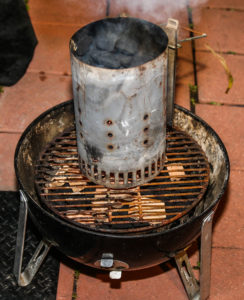
What you will need to do is lay the charcoal and hickory into the coal pan of the smoker. Once placed, the chimney starter will be lit from the bottom to start the flame without lighter fluid. You can either use newspaper or Weber ignition cubes to get the fire started. The goal here is to get the coals in the chimney smoking and red hot so that you can dump them into the coal pile below. Avoiding lighter fluid is important here because the gasoline/lighter fluid smell will get into the food which will make for some unappetizing eats!
Meat Preparation
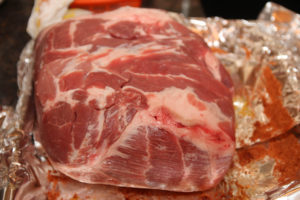
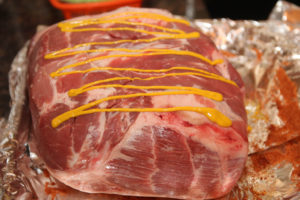
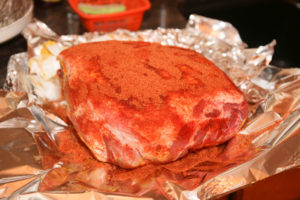
While the chimney is smoking, grab some pork shoulder and lightly apply yellow mustard. The mustard will work to hold the rub to the pork shoulder while it smokes to help the rub caramelize and give the pork shoulder nice bark. Once light mustard is applied, add on the rub on both sides of the pork shoulder
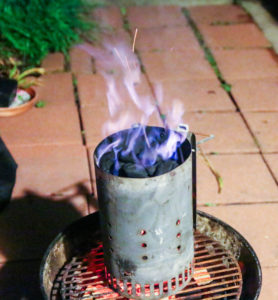
Once the chimney is on fire you will need to exercise caution to pick up the chimney starter, remove the grate and dump it onto the bed of coal and wood below.
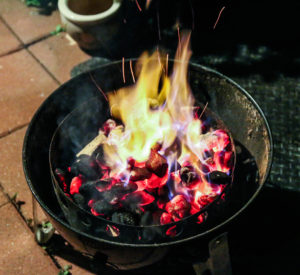
By dumping the hot chimney coals to the pile below, it will ignite the rest of the coals without the use of lighter fluid and sustain itself for a prolonged period of time.
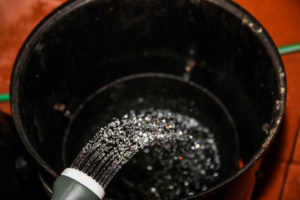
Next up fill your water pan with a watering can, this will help regulate temperature as well as generate additional smoke.
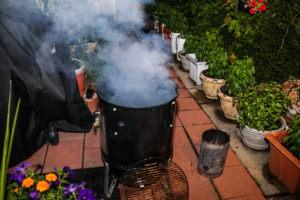
Once you have the smoker up and running you will have smoke from coal and wood that will run for a good 5-7 hour stretch before the temperature starts to diminish.
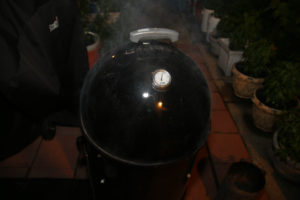

The trick with smoking meat is to try to keep the temperature low and slow. Too much heat and you will end up burning the meat. Not enough heat and the meat will not get past the stall and will not be as tender as you need it to be.
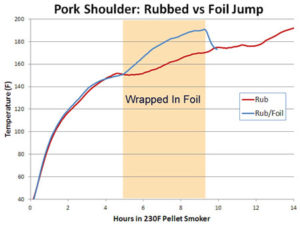
Source: Amazingribs.com
Smoking meat is somewhat of a marathon. The target temperature to hit with most meat is about 200 degrees F. At this point, meat tenderizes and reaches peak flavor. While it’s still possible to eat pork shoulder at 180 or even 190F, I’ve definitely seen that breaking past 200F will yield great results. Some people will go 215F but risk the meat drying out when smoked for that long. When smoking meat applying some apple cider with a spray bottle about 5 hours into the smoke. You can also wrap the pork shoulder in foil and spray the shoulder, this Texas Crutch will help speed up the process and shave off a few hours off the total smoke time.
After 6 hours the coals will die down, so at that point apple cider vinegar will be misted on the shoulder and you can either finish it up in the oven or load a new chimney or charcoal and keep going. It’s up to you if you want to wrap the pork shoulder or let it ride on the smoker. Since I was in a time crunch I decided to deploy the Texas Crutch and bring the pork shoulders to the finish line.
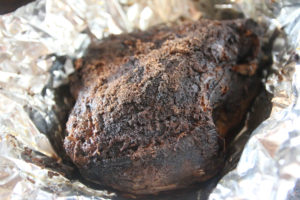
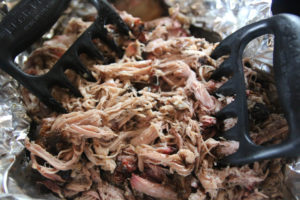
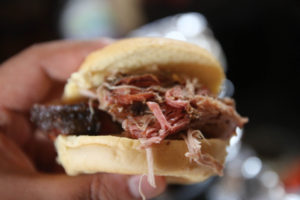
Once the pork shoulder eclipses 200F, it is time to let it sit in a tray and cool off and rest. This resting period lets the pork shoulder reabsorb some of the juice that may be in the foil to get juicier pork shoulder. Once the shoulder is rested 45 minutes to 1 hour, take your favorite set of bear claws and start ripping up the pork. You’ll find it therapeutic but if you have no bear claws you can use your bare hands or two fork method. Since I got a set of bear claws I’ve never had to turn back. After you’re done, it’s ready to go, make sure to mix up the pork shoulder and make sure the juice gets on a lot of pieces. One 9lb of pork shoulder should be able to feed 20 people or so, so not bad in a long night’s work.







